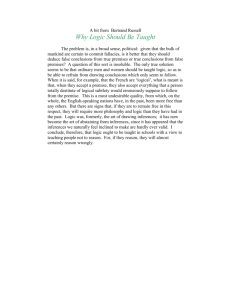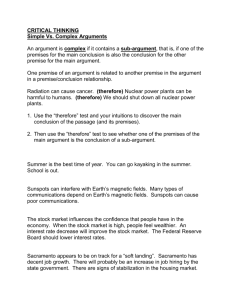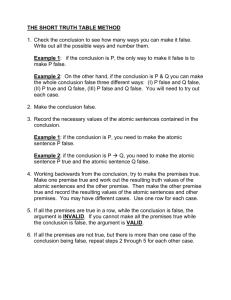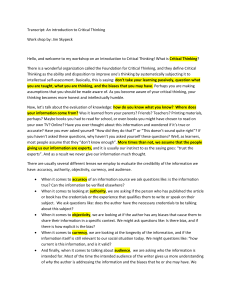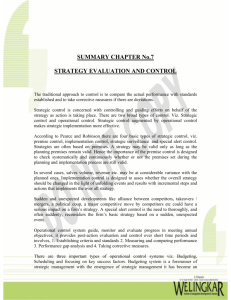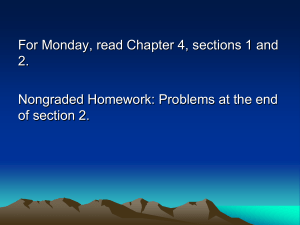Title: Manifestly Adequate Premises Author: Jean Goodwin
advertisement
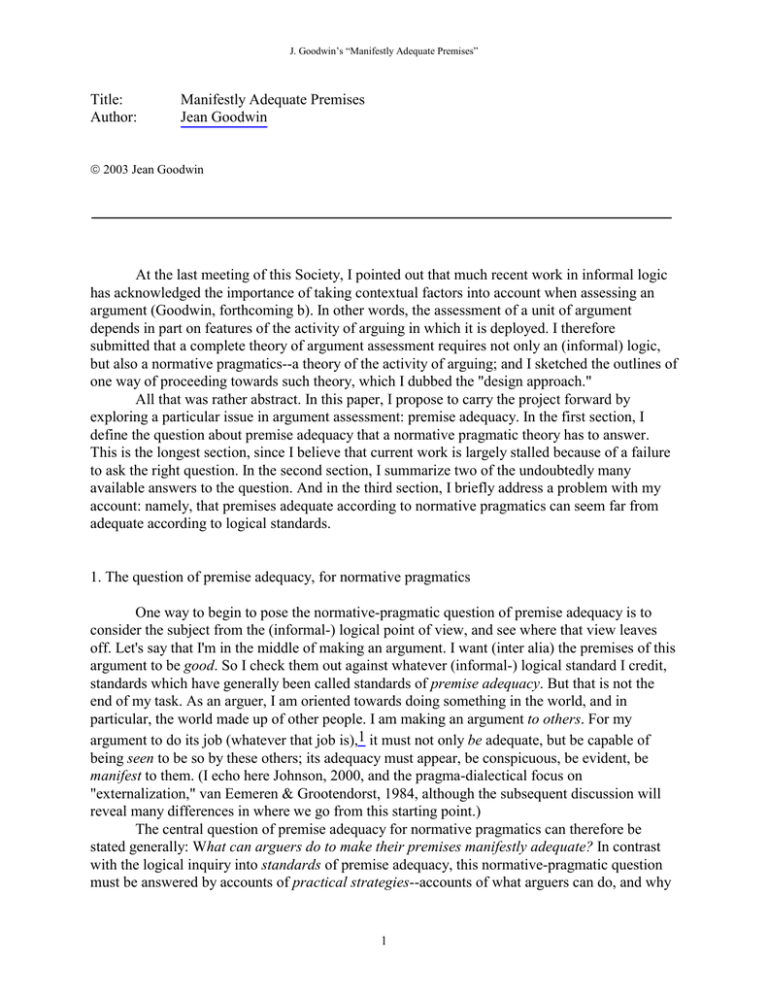
J. Goodwin’s “Manifestly Adequate Premises” Title: Manifestly Adequate Premises Author: Jean Goodwin Commentary: J. Hoaglund © 2003 Jean Goodwin At the last meeting of this Society, I pointed out that much recent work in informal logic has acknowledged the importance of taking contextual factors into account when assessing an argument (Goodwin, forthcoming b). In other words, the assessment of a unit of argument depends in part on features of the activity of arguing in which it is deployed. I therefore submitted that a complete theory of argument assessment requires not only an (informal) logic, but also a normative pragmatics--a theory of the activity of arguing; and I sketched the outlines of one way of proceeding towards such theory, which I dubbed the "design approach." All that was rather abstract. In this paper, I propose to carry the project forward by exploring a particular issue in argument assessment: premise adequacy. In the first section, I define the question about premise adequacy that a normative pragmatic theory has to answer. This is the longest section, since I believe that current work is largely stalled because of a failure to ask the right question. In the second section, I summarize two of the undoubtedly many available answers to the question. And in the third section, I briefly address a problem with my account: namely, that premises adequate according to normative pragmatics can seem far from adequate according to logical standards. 1. The question of premise adequacy, for normative pragmatics One way to begin to pose the normative-pragmatic question of premise adequacy is to consider the subject from the (informal-) logical point of view, and see where that view leaves off. Let's say that I'm in the middle of making an argument. I want (inter alia) the premises of this argument to be good. So I check them out against whatever (informal-) logical standard I credit, standards which have generally been called standards of premise adequacy. But that is not the end of my task. As an arguer, I am oriented towards doing something in the world, and in particular, the world made up of other people. I am making an argument to others. For my argument to do its job (whatever that job is),1 it must not only be adequate, but be capable of being seen to be so by these others; its adequacy must appear, be conspicuous, be evident, be manifest to them. (I echo here Johnson, 2000, and the pragma-dialectical focus on "externalization," van Eemeren & Grootendorst, 1984, although the subsequent discussion will reveal many differences in where we go from this starting point.) The central question of premise adequacy for normative pragmatics can therefore be stated generally: What can arguers do to make their premises manifestly adequate? In contrast with the logical inquiry into standards of premise adequacy, this normative-pragmatic question must be answered by accounts of practical strategies--accounts of what arguers can do, and why 1 J. Goodwin’s “Manifestly Adequate Premises” doing just that will work. In the technical vocabulary of classical rhetoric, what is sought is an understanding of our methods for inventing (creating, discovering) manifestly adequate premises; in more contemporary terms, methods for designing them. Well, what can arguers do to make their premises manifestly adequate? As a first approximation to a solution, one response seems uncontroversial. Arguers can proceed by communicating. Communication, after all, is the ordinary method we use to get things done in a world made up of other people. And in communication things that might otherwise be hidden (e.g., states of mind) get openly displayed. So if we had an idea of how communication works in general, we might be able to refine and limit our central question about how to make premises manifestly adequate, thus limiting also the terrain in which we need to seek for an answer. I am going to proceed, therefore, by bringing a pair of alternative conceptions of communication to the normative-pragmatic question of premise manifest adequacy; beginning, in standard dialectical fashion, with what I take to be the wrong one. 1.1. Communication as encoding How can a premise be made manifestly adequate? Take a logically adequate premise, encode it into some conventionally appropriate linguistic form (e.g., an English sentence that expresses it), and convey it in some appropriate medium (e.g., an email) to the addressee, who then decodes it.--This would be the advice of what has been called the "code" (Sperber & Wilson, 1988) or "conduit" (Reddy, 1979) model of communication. In this conception, the primary practical problems an arguer has to address are the errors that creep in during the process--errors in encoding, errors in transmission, errors in decoding. The central question for a "code" approach to premise adequacy would therefore be: What can arguers do to prevent such errors? This proposal is attractive: it gets the premises out there into the world, it makes them manifest. But will a strategy of encoding adequate premises be expected to work? Is it a durable strategy, one able to stand up to the difficulties arguers ordinarily face in arguing? No. Encoding and transmitting an adequate premise may indeed make manifest what the premise of an argument is. But encoding and transmitting does not make manifest the quality of that premise, viz. whether it is adequate or not. The addressee of an encoded premise, even when strategies are adopted to ensure that the entire encoding/transmission/decoding process goes right, may still reply: "I see that you're telling me that p, therefore q. But I don't see p as adequate; indeed, I doubt it." How could the arguer respond to this challenge, according to the code model? She would have to launch a defense of the premise, presumably by making further arguments. But the premises of these could be challenged in turn, leading to an extended regress. Regress, however, will almost always be impractical. The arguer wants her original argument to do a job. Generally, she and her addressee both have limited time to devote to the matter. Not to achieve manifest premise adequacy within this limited time is effectively not to achieve it at all. Simply encoding and transmitting an adequate premise thus seems an unworkable strategy. So consider this revision of the basic "coding" strategy. The arguer is conceived to encode and transmit a premise, but that premise must be one that the addressee already finds adequate. Communication makes the premise manifest; the addressee himself admits its adequacy; the result is therefore a manifestly adequate premise. This is the strategy implicitly proposed by those 2 J. Goodwin’s “Manifestly Adequate Premises” theorists (e.g., Johnson, 2000; Tindale, 1999) who defend (at least in part) a "dialectical" or "rhetorical" standard of premise adequacy, according to which premises are deemed good if they are in fact accepted by those to whom the argument is addressed. Even this revised strategy encounters serious difficulties, however. First, what happens when the addressee is simply ignorant? Jurors, for example, are selected specifically because they have no knowledge of the matter being tried; does that mean that an argument addressed to jurors can never have manifestly adequate premises? Second, the revised strategy puts a heavy burden on the arguer. How is she to discover what her addressee accepts and does not accept? Some sort of research into the other's thoughts would seem to be required, research which can be time-consuming and often fruitless. (We don't really know much about what others are thinking; I am frequently surprised to discover the odd beliefs of people I know well--for example, those of one friend who sews crystals into all her clothes.) But if it's difficult to determine what premises an addressee accepts, the revised strategy of "encoding" accepted premises is impractical. The revised strategy, finally and most importantly, encounters the problem of noncooperation. Even if the arguer hits the mark and presents a premise that the addressee finds adequate, that fact may not itself be manifest. Rather, the addressee may refuse to recognize the premise's adequacy, or may even manifestly doubt or challenge it. This is especially likely to happen under conditions of open and deep disagreement, in which the addressee has little motive to cooperate with the arguer's attempts to move him. But precisely such conditions prevail in many of the instances where we most want arguing to work--for example, in highly adversarial trials, or on hotly contested political issues.2 In sum, error-free encoding of adequate premises may be a workable strategy in some cases, but it can hardly be expected to work in general. What is needed is a strategy or strategies not only to make a premise manifest, but to create or even force recognition of its adequacy from even noncooperative addressees. And to see how such a strategy might work will require conceiving communication as more than just a process of encoding and transmission. 1.2. Communication and force We can begin by asking how we ever exert force on each other. How, short of physical coercion, can we at all expectably obtain responses from each other? Consider this story. Every day Fred walks his dog. For motives of my own, I want Fred to head north. Physical coercion is out; it's not only unjustified, it would be ineffective. So I go about making a change in Fred's world: I dig deep ditches around his house, to the east, west and south. I reason that Fred will recognize the ditches, that he will find it inexpedient to climb over them, and that he will thus find he has good reason to walk north. By making a change in his world that gives him a reason, I've exerted force on him to walk north Turn now to the force of communication: what we should take as the spectacularly mysterious ability of sound waves, ink spots or pixels to expectably secure responses. The line of theorizing useful reviewed by Kauffeld (2001, forthcoming) has given an account of the force of speech acts that runs in parallel with this simple case. Communication, in this view, does not gain force simply through being encoded in a conventionally established form. Rather, the fact that an utterance is made creates a reason of some sort for the auditor to respond. Take the basic 3 J. Goodwin’s “Manifestly Adequate Premises” act of saying something as an example. In saying that p, a speaker openly takes responsibility for it being the case that p. (The complex intentions which constitute the act of saying something are just what is necessary to commit speaker to truth of matter stated, and to do so openly; see Kauffeld, following Stampe, 1967, for details.) Her utterance has thus changed the world in a certain way. It has introduced a new fact, viz. that she can be held responsible for the truth of what she said. Recognizing this fact, the auditor can infer that p, reasoning that it would be unlikely for the speaker to make herself thus vulnerable if she did not herself believe that p, or if her belief was ungrounded. By making a change in his world that gives him a reason, the speaker has thus exerted force on the auditor to believe. Of course, force generally falls short of necessity: Fred can scramble over the ditch, and auditors can still distrust speakers. The practical strategies can in turn be elaborated to respond to these or other specific difficulties: I can dig the ditch deeper, or fill it with pointed spikes; the speaker can post a $100 bond. Limitation and elaboration are in the nature of strategies. Even limited, even unelaborated, however, the strategies have some force. They have so changed the world as to provide a reason. Because of the stress this view puts on the auditor's reasoning, it has been termed the "inferential model" of communication (Sperber & Wilson, 1986; or more obscurely, the "toolmaker's paradigm" by Reddy, 1979). Let us return then to apply this alternative model of communication to the question of premise adequacy. It is, as before, the arguer's task to make the adequacy of her premises manifest to her auditor. Assume she accomplishes this task through forceful communication. She makes some change in the world, a change that, when noticed, gives her auditor reason to recognize the adequacy of her premises. Whatever other difficulties this strategy may encounter, it is at least sufficient to address the three problems that sunk the strategy of "encoding" premises. Giving the auditor a reason to recognize the adequacy of her premises will overcome his ignorance of the matter at hand, side-step her ignorance of his state of mind, and exert at least some force on the noncooperative. The central question for a normative-pragmatic theory of premise adequacy is therefore: What changes can an arguer make in the world, that will give her auditor reason to recognize the adequacy of her premises?3 Answering that question will require inquiries into both "sides" of the equation (Goodwin, forthcoming b). On the arguer's side, we will need to analyze precisely the activities available to her. On the auditor's side, we will need to reconstruct why the arguer's doing just that creates a reason for the him to respond as desired. 2. Two strategies for establishing manifestly adequate premises In this section I will sketch rapidly two strategies that can render premises manifestly adequate, leaving out most of the detailed support I have assembled in other work (Goodwin, forthcoming a). I present one strategy from each of the two main contexts of traditional interest to rhetoricians: forensic arguments about guilt and innocence, as represented by the AngloAmerican jury trial, and deliberative arguments about what to do, as represented by debates in the U.S. Congress. For each strategy, I attempt to answer the central question, saying both what and why. What counts as a good premise at an Anglo-American jury trial? The local norm is clear: advocates in their arguments to the jury, jurors in their arguments to each other, can only use the 4 J. Goodwin’s “Manifestly Adequate Premises” evidence introduced at the trial. What then is evidence?--what change does an arguer need to make in the world, to make something evidence? To be evidence, first, some matter--an object or a person's statement--must be made evident to the trial participants. It must be ostended to them, ideally in it's original form. The hearsay rule, as is well known, bars second-hand statements from counting as evidence; the related "best evidence" rules prohibit copies, where originals are available. To be evidence, furthermore, the matter must be made evident to them all at once. Jurors are forbidden from making independent investigations, such as private visits to the crime scene; indeed, if even one of them is absent, the evidentiary process stops. Why does this sort of ostension in the presence of all create a reason for trial participants to recognize that what is ostended is an adequate premise? In an obvious way, the process of introducing evidence gives all the participants reason to credit it: having seen the knife or heard the witness's testimony, the participants can reasonably believe that knife or testimony exists. Moreover, the process also gives all participants reason to recognize that adequacy. Each was seen by all when seeing and hearing the evidence, and so can hardly now deny it. Admittedly, the force of this strategy seems limited. The evidentiary process serves to make manifest premises like "the knife was crusted" or "the witness testified that the defendant was his attacker." It does not create more powerful premises like "the knife had the victim's blood on it," or "the defendant attacked the witness." But even such small gains are useful, especially in the highly adversarial terrain of the jury trial, where the parties have little reason to cooperate with each other. Nothing like evidence is deployed in the deliberations on the floor of the U.S. Congress. Nothing is ostended there beyond the discourse of the members themselves, and the members are seldom all there at once. What then counts as a good premise in this context? One characteristic of members' arguing is its reliance on testimony of various sorts. But members often do not recognize that testimony is adequate; instead, they challenge it. One side's expert, for example, is confronted with the other side's expert, with allegations of bias, or with reasoning that suggests that the expert's opinion is baseless. On the other hand, there are a few types of testimony that do routinely escape challenge. When one side quotes the other side's expert--for example, when a minority member quotes an Administration official--the other side does not object. And when a member cites a statement of one of his own constituents, no other member challenges. In these cases it is not testimony, but specifically testimony from a person who is in some way identified with a member, that is allowed to stand as an adequate premise. What reason does one member's presentation of such "identified" testimony give to others to recognize its adequacy? In both these cases, there are local norms which effectively put the statements beyond criticism. For the experts' statements, the relevant norms are those against self-contradiction, and requiring party loyalty. For the constituents' statements, the relevant norm is one of deference to other members' constituent service--the same norm that allows pork-barrel projects to go forward unchallenged. Opposing members are unable to challenge the premises without violating these norms, and thus have reason to recognize (or at least, act like they recognize) them as adequate premises. 3. Manifest adequacy and premise goodness To reprise: If an arguer wants her premise to do its job within the activity of arguing, she must ensure that it not only is adequate, but that her auditor will recognize it as such; in other 5 J. Goodwin’s “Manifestly Adequate Premises” words, that it is manifestly adequate. Since she can often expect her auditor to be recalcitrant, she must adopt a practical strategy to force him to recognize premise adequacy. She must so change the world as to give her auditor reason to do this. One such strategy in forensic arguing is that of introducing evidence; in deliberative arguing, that of deploying testimony that local norms put beyond criticism. In developing this account, we have traveled quite far--in fact, perhaps too far. I want to close by considering a general problem this distance has given rise to. In the "encoding" strategy, (informal-) logical and normative-pragmatic adequacy necessarily align, since what is made manifest is nothing other than the logically adequate premise itself. But if the strategies of force allow a single, unqualified statement from a constituent to be a manifestly adequate premise in a debate on a complex issue of national policy, then it certainly looks like manifest adequacy has drifted far from anything that could be called adequate according to the standards of (informal-) logic. The two types of adequacy seem to conflict, or at least to be so independent of one another that it is hard to see how they fit together into a single, inclusive account of premise goodness. Let me begin by making clear what this problem does not involve: it does not involve a division between assessing premises to be good or bad and reckoning them to be successes or failures. For all three manifestly adequate examples discussed above, success depends upon goodness of some sort. The strategies have force because they create reasons, and the reasons they create are grounded on norms (taking that term generally to embrace all our tools of assessment). The norms invoked are quite varied. The strategy of evidence works because no one can deny having seen or heard the items ostended. Why not? Since everyone saw each other seeing the evidence, to deny having seen it would either be to lie (bad) or to admit to having been inattentive at trial (also bad). The strategy of deploying the other side's experts is effective because they can't challenge it. Why not? If they did, it would mean that their own expert had judged wrongly in some way (bad). And even the inability to challenge the statement of another member's constituent is grounded in a conception of the duties of representatives in a democracy. The problem is not a gap between normative goodness and brute factual effectiveness, but rather a lack of coordination or even tension between two sets of norms: the (informal-) logical norms of premise adequacy, and the rather more varied norms through which premises gain pragmatic force. This failure of fit is what Blair and Hansen (2001) have called the "integration problem": the problem of how to construct a unified theory of argumentation out of the quite diverse perspectives that various fields bring to the subject. As the authors comment, "If we want it to be a theory that facilitates the bringing to bear of the standards of logic, dialectics and rhetoric on argumentation, then one of the most important things the theory will have to do is to show how the three distinct sets of [assessment] standards can be brought into harmony." The account of normative-pragmatic premise adequacy given in this paper suggests on one hand that we will not be able to resolve the integration problem, at least not in all cases. Political theorists at least as far back as Edmund Burke have debated the correct balance between a representative's duty to her constituents and her need to exercise her own best judgment (including her judgments of the logical adequacy of her premises). It's unlikely that argumentation theorists are going to resolve this enduring value conflict. Instead, as long as we remain committed to representative democracy, we will have to put up with the fact that premises manifestly adequate because of respect for constituent service will occasionally be at odds with premises adequate on logical grounds. 6 J. Goodwin’s “Manifestly Adequate Premises” On the other hand, there also seems to be reason for hope. The force of the other two practical strategies discussed above comes from their turning a spotlight on shady dealings with premises. They use the force of publicity to ensure that logically adequate premises are recognized, or to encourage arguers to only produce premises logically adequate. The forensic strategy of introducing evidence forces even the most recalcitrant to recognize what manifestly is the case. The deliberative strategy of deploying testimony from experts "identified" with the other side works backwards; it does not necessarily secure the recognition of logically adequate premises, but it does ensure that arguers will be accountable for inadequate ones. If everyone knows that they will be held publicly responsible for what "their" experts say, they will be motivated to be more careful to follow those expert judgments, and make their experts take better care in judging as well. Thus while manifest and logical adequacy may not line up in the short run, there are pressures forcing them into alignment over time. If this result extends beyond the two cases considered here, the best response to the integration problem, at least for premise adequacy, may be that of Aristotle, who pointed out that since what is true is in itself stronger, it's our own fault if we fail to use the available means for making that strength manifest. Notes 1 Arguing and persuading. A person who argues aims achieve something in the world constituted by other people; in that sense, to argue counts as an attempt to persuade, taken "persuasion" generally. But, as I have also contended elsewhere, we should not assume that to argue that p is necessarily to attempt to persuade that p (1999, 2002). Thus, for example, an important goal of arguing that p can be to persuade the auditor to consider seriously whether p. A full normative pragmatic theory of arguing would have to account for the many jobs arguing can do. 2 Arguing and noncooperation. There are certainly cases where arguers do cooperate with each other in their arguing. And there are also clear cases in which arguing does its job, even though the arguers are manifestly noncooperative (Goodwin, 2001b). Which of these should be taken as paradigmatic for theory construction? If we want the theory to be robust, we should not build it on optimistic assumptions. Instead, we should follow Henry Johnstone and take radical disagreement as our starting point (Goodwin, 2001a): disagreement not only about the issue at hand, but about how to transact the disagreement. If a normative pragmatic theory of arguing can show how arguing can work even in such cases, then it may have some traction against the sorts of problems in the world we'd like it to. 3 On three different ways reasons enter into the activity of arguing, and the shape of a theory of argumentation. If what I have said is correct, it becomes possible to distinguish more clearly among: 7 J. Goodwin’s “Manifestly Adequate Premises” R1: The reasons an arguer gives to her opponent as arguments. R2: The reasons that a speaker's activity gives to her auditor, forcing a response. R3: The reasons an actor has for engaging in an activity. All activities presumably have R3; they are practically rational. All communication presumably has R2 in addition: communication has R3 because it expectably creates R2; the activities of both speaker and auditor are practically rational. Arguing, uniquely among communicative activities, also has R1: it has R3 because it creates R2 to deal seriously (or in some desirable fashion) with R1. The central task of an (informal-) logical theory is to make explicit the goodness of R1 (and, of course, the badness of some apparent reasons that should not, therefore, count as R1). The central task of a normative-pragmatic theory of arguing is to make explicit the goodness of R2 and R3, for the activity of arguing (and, again, correlative badness); to put this another way, a normative pragmatic theory of arguing attempts to reconstruct the practical rationality of the activities that create communicative forces in arguing. A solution to the "integration problem" (Blair & Hansen, 2001) will be an account of how the goodness of R1 contributes to the goodness of R2 and 3; and conversely, how the goodness of R2 and 3 contributes to the goodness of R1. Since R2 and 3 are quite diverse, we can expect the solutions to be similarly diverse References Blair, J.Anthony and Hans V. Hansen. 2001, November. Informal Logic and Future Research. National Communication Association Convention, Atlanta, GA. Eemeren, Frans H. van and Rob Grootendorst. 1984. Speech Acts in Argumentative Discussions: A Theoretical Model for the Analysis of Discussions Directed towards Solving Conflicts of Opinion. Dordrecht: Foris. Goodwin, Jean. 1999. "Good Argumentation without Resolution." In Frans H. van Eemeren et al. (eds.), Proceedings of the Fourth International Conference of the International Society for the Study of Argumentation, 255-259. Amsterdam: Sic Sat. Goodwin, Jean. 2001a. "Henry W. Johnstone's Still Unacknowledged Contributions to Contemporary Argumentation Theory." Informal Logic 21:41-50. Goodwin, Jean. 2001b. "The Noncooperative Pragmatics of Arguing." In Eniko T. Nemeth (ed.), Pragmatics in 2000: Selected Papers from the 7th International Pragmatics Conference, 2.263277. Antwerp: International Pragmatics Association. Goodwin, Jean. 2002. "Designing Issues." In Frans H. van Eemeren et al. (eds.), Dialectic and Rhetoric: The Warp and Woof of Argumentation Analysis, 81-96. Amsterdam: Kluwer. 8 J. Goodwin’s “Manifestly Adequate Premises” Goodwin, Jean. Forthcoming a. "Designing Premises." In Frans H. van Eemeren & P. Houtlosser (eds.), The Practice of Argumentation. Amsterdam: John Benjamins. Goodwin, Jean. Forthcoming b. "One question, two answers." In Proceedings of the Ontario Society for the Study of Argumentation Conference, 1999. Johnson, Ralph. 2000. Manifest Rationality: A Pragmatic Theory of Argument. Mahwah, N.J.: Lawrence Erlbaum. Kauffeld, Frederick J. 2001. "Argumentation, Discourse, and the Rationality Underlying Grice's Analysis of Utterance-Meaning." In Eniko T. Nemeth (ed.), Cognition in Language Use: Selected Papers from the 7th International Pragmatics Conference, 1.149-163. Antwerp: International Pragmatics Association. Kauffeld, Frederick J. Forthcoming. "Grice without the Cooperative Principle." In Proceedings of the Ontario Society for theStudy of Argumentation Conference, 1999. Reddy, Martin J. 1979. "The Conduit Metaphor: A Case of Frame Conflict in our Language about Language." In Anthony Ortony (ed.), Metaphor and Thought, 284-297. Cambridge: Cambridge University Press. Sperber, Dierdre and Dan Wilson. 1979. Relevance: Communication and Cognition. Cambridge, MA: Harvard UP. Stampe, Dennis. 1967. "On the acoustic behavior of rational animals." University of Wisconsin, Madison: Photocopy. Tindale, Christopher W. 1999. Acts of Arguing: A Rhetorical Model of Argument. Albany, NY: SUNY Press. 9
